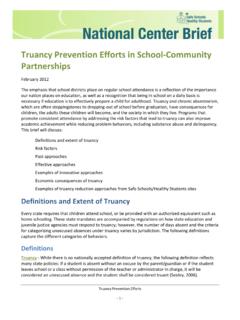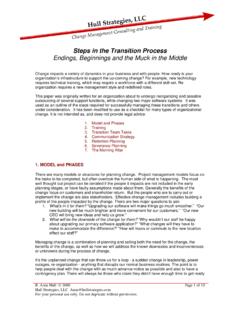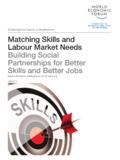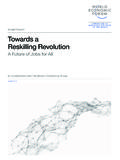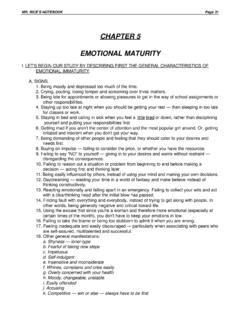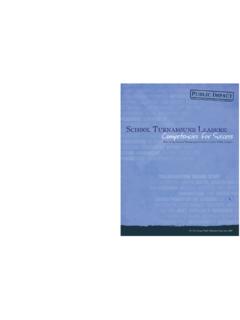Transcription of Strategies for Engaging Immigrant and Refugee …
1 Strategies for Engaging Immigrant and Refugee FamiliesStrategies for Engaging Immigrant and Refugee FamiliesiiAcknowledgementsThe National Center for Mental Health Promotion and Youth Violence Prevention at Education Development Center, Inc. (EDC), in partnership with American Institutes for Research (AIR), provides technical assistance and training to Safe Schools/Healthy Students (SS/HS) grantees. SS/HS grantees are funded by the Departments of Education and Justice, as well as the Substance Abuse and Mental Health Services Administration (SAMHSA). Education Development Center, Inc., StaffCarol Bershad, WriterJoshua DeGregorio, Graphic DesignerBen Spooner, Research AssistantSafe Schools/Healthy Students Technical Assistance SpecialistsJennifer Anthony, EDCJack Campana, EDCN ancy Kelly, EDCMary Thorngren, AIRC ynthia Wright, EDCSafe Schools/Healthy Students GranteesLaurel Bear, Project Director, Alhambra Unified School District, Alhambra, CAKim Desso, Early Childhood Prevention Coordinator, Lewiston Public Schools, Lewiston, MEBen Franco, Project Director, Donna Independent School District, Donna, TXJane Garland, Project Director, Newport-Mesa Unified School District, Costa Mesa, CARosemary Kooy, Project Director, Lewiston Public Schools, Lewiston, MERon Taglienti, Mental Health Coordinator, Lewiston Public Schools.
2 Lewiston, MEOther ContributorsDeborah Bryant, Galileo Academy Wellness Initiative, San Francisco Unified School District, San Francisco, CAUlash Dunlap, Richmond Area-Multi-Services (RAMS), Inc., San Francisco, CABeth Mastin, Program Director, New Routes to Community Health, Madison, WIPhotographyPhoto Credits: cover, top left: Jack Hollingsworth/Getty Images; cover, remaining photos: ; Pages 1, 6, 9: Alhambra Unified School District; pages 3, 4: New Routes to Community Health; page 7: Newport-Mesa USD; page 7: Lewiston Public Schools; page 10: Donna Texas ISD. Strategies for Engaging Refugee and Immigrant families is available electronically on the National Center for Mental Health Promotion and Youth Violence Prevention s website, 2011 by Education Development Center, Inc.
3 All rights for Engaging Immigrant and Refugee FamiliesiiiContentsIntroduction ..1 Strengths and Challenges of Immigrant / Refugee Communities ..2 Engaging Immigrant families in School and Health Issues ..2 Using Media to Do Outreach: New Routes to Community Health ..3 Salud: Healing Through the Arts (Chicago) ..3 Egal Shidad: (Minneapolis/St. Paul) ..4 Successful Outreach Examples SS/HS Sites ..6 Newport-Mesa Unified School District (California): Bilingual Outreach ..6 Lewiston Public Schools (Maine): Home Visits and Parenting and Literacy Support ..7 Alhambra Unified School District (California): Multi-Lingual Parent University ..8 Donna (Texas): Collaborating with Community Advocacy Leaders and Bringing Services to the Community ..9 Strategies for SS/HS Programs to Engage Immigrant and Refugee Communities.
4 11 Strengthen Relationships Between families , the School, and the Community ..11 Empower Immigrant Youth and families ..12 Support Language Differences ..12 Respect Diversity of Needs ..12 Focus on Student Success ..13 Additional Resources ..13 Notes ..14 Strategies for Engaging Immigrant and Refugee Families1 IntroductionAmerican classrooms have become increasingly diverse. Immigrants and refugees * now comprise over 20 percent of the students in public schools, and this percentage is expected to grow to 30 percent by The number of English language learners has also increased, doubling in size from 1995 to These diverse students hail from every corner of the world, with 39 percent of immigrants coming from Mexico, 23 percent from Asia and the Pacific Islands, 11 percent from Europe, 6 percent from Central America and the Caribbean, 5 percent from South America, and 3 percent from Immigrants no longer reside mainly in urban areas but have dispersed to rural communities, where historically.
5 There has been little diversity and certainly far less experience working with Immigrant and Refugee Many Safe Schools/Healthy Students (SS/HS) sites across the United States have substantial Immigrant populations and are interested in better understanding their diverse communities so that they may do more effective outreach to engage families in SS/HS programs. * The term immigrants will be used throughout this document although some Immigrant populations officially have Refugee status. The distinction is that immigrants choose to come to the United States while refugees are people who have been forced to flee their countries for fear of persecution due to war, religion, or political opinion. refugees have a different legal status that is defined by the United for Engaging Immigrant and Refugee Families2 Strengths and Challenges of Immigrant / Refugee CommunitiesDespite their diversity, Immigrant families often share similar strengths.
6 They are more likely to have two parents, with at least one working parent, and often have strong community connections as well as support from extended family5 all protective factors for children against risky health behaviors. In addition, many Immigrant families have a strong desire for their children to be successful in school and in life and have an ethic of hard work to get ahead. Immigrant families have often demonstrated great resilience in overcoming obstacles to come to the United with all these strengths, Immigrant children and families frequently struggle in their new communities. Some may be dealing with past traumas from persecution, conflicts, or natural disasters in their home countries. Some may have limited education or non-transferable job skills and so are unable to find sufficient work to adequately support their families .
7 Some may have come from rural farming communities and find themselves in unfamiliar urban areas. Others may be undocumented families or parents who fear exportation, a significant stressor that may keep them from finding higher-paying jobs or receiving health care, or prevent their children from seeking higher education. Still others may be highly educated professionals who are unable to find comparable positions in their new communities. But Immigrant families also share some common denominators. Many families have experienced separations for extended periods as children are sent ahead to live with relatives, or parents emigrate first in order to establish a life before sending for their families . There is the stress of dislocation to a new environment and culture.
8 After arrival, they face the challenge of adapting to a new culture and learning new rules and roles. They may experience conflict between generations as children and youth often acculturate more quickly than their parents. Many parents experience the stress of not being able to speak the language, with adult and child role reversal when children learn English more quickly and need to act as interpreters and negotiators with health care and school officials. And as parents experiences may not be as relevant in the United States as in their country of origin, parents may feel diminished and disempowered from their roles as respected elders and experts. Finally, immigrants may also experience resentment, discrimination, and hostility in their new ,7 Engaging Immigrant families in School and Health Issues To have a significant impact on improving the health and well-being of chil-dren in Immigrant families , it is important to focus on the unique circumstances of the groups who are struggling the most to succeed in this country.
9 Indi-vidual and family characteristics, reasons for immigration, and the social con-text families find upon their arrival, all play an important role in understanding these differences. Shields and Behrman (2004, p. 4)SS/HS initiatives often find it challenging to successfully engage Immigrant families . Low participation rates of minority parents at school activities is an ongoing concern for educators and school-based mental health providers, as family involvement in children s academic and behavioral performance, both in school and at home, is crucial to the success of academic and mental health If families don t respond to traditional engagement Strategies , school and health care staff may assume parents aren t interested. The reality is that most Immigrant families care deeply about their children s education and health.
10 However, immigrants often show respect for schools by keeping their distance; the unspoken norm in many countries outside of the United States is that it is the teacher s job to educate their children, and thus it is disrespectful to a teacher s expertise for parents to Other factors that may Strategies for Engaging Immigrant and Refugee Families3influence parental engagement are the parents limited English language proficiency, which affects their comfort level; parents negative perceptions of the school environment; and the lack of culturally competent staff to provide culturally appropriate outreach to Immigrant families . Parents work schedules, limited English language fluency, limited formal education, and a lack of resources, such as a home computer, may also impede their ability to help their children with homework.


